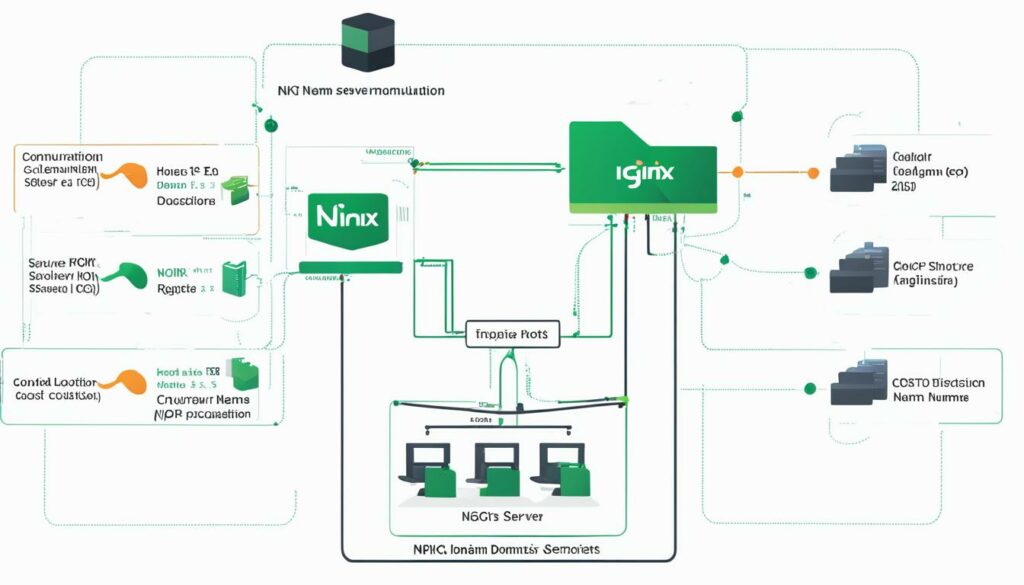Welcome to our comprehensive guide on configuring virtual hosts for hosting multiple domains on a single server. Whether you are a website owner, developer, or IT professional, this article will provide you with a step-by-step walkthrough of setting up virtual hosts using popular web servers like Apache and Nginx.
Configuring virtual hosts is a crucial skill for those who want to efficiently manage multiple websites on a single server. By using virtual hosts, you can serve different domains or subdomains from one server, saving resources and reducing costs.
In this guide, we will first explain what virtual hosts are and how they work. We will then delve into the specific steps required to configure virtual hosts in both Apache and Nginx. We will provide detailed instructions, configuration examples, and troubleshooting tips.
Additionally, we will cover important topics such as SSL configuration for virtual hosts and best practices for virtual host setup. Securing your websites with SSL certificates and following best practices will ensure optimal performance and security.
To illustrate the concepts discussed, we will use real-world examples and provide practical advice based on our experience. We aim to empower you with the knowledge and tools to successfully configure virtual hosts and host multiple websites on one server.
Key Takeaways:
- Configuring virtual hosts allows you to host multiple domains or subdomains on one server.
- Virtual hosts can be set up using web servers like Apache and Nginx.
- Apache’s virtual host configuration involves specifying the ServerName or ServerAlias for each domain.
- Nginx defines virtual hosts as server blocks with server_name directives.
- Troubleshooting virtual host configuration issues in both Apache and Nginx requires checking the syntax and verifying settings.
What are Virtual Hosts?
Virtual hosts are a powerful tool that allows you to host multiple websites on a single server. When a visitor types a domain name into their browser, it sends a request to your server’s IP address. In response, the web server serves up the content of the requested domain name. Traditionally, if you wanted to host multiple websites, you would need separate servers for each site, leading to increased costs and inefficiencies.
However, with virtual hosts, you can serve different content for different domains from one server. This means that you can host multiple domains and subdomains on the same machine, saving you money and resources. Virtual hosts are commonly used with both Apache and Nginx servers to create a seamless hosting environment for multiple websites.
When a request comes in, the server checks the domain name in the request and serves the corresponding website’s content. This process is known as name-based virtual hosting. Instead of using physical servers for each site, virtual hosts allow you to use a single server, making it easier to manage and maintain your websites.
In the world of hosting, virtual hosts are a game-changer. They provide flexibility, scalability, and cost-efficiency, ensuring you can meet the demands of hosting multiple domains without breaking the bank.
Hosting multiple websites on one server brings several benefits, including efficient resource management and streamlined website management. By using virtual hosts, you can optimize your server’s performance by serving multiple websites from a single machine.
In the following sections, we’ll explore how to configure virtual hosts in both Apache and Nginx, troubleshoot common issues, and implement best practices for a secure and high-performing hosting environment.
Configuring Virtual Hosts in Apache
When it comes to configuring virtual hosts in Apache, the process involves specifying the domain name associated with each virtual host. To create a virtual host, you need to define the ServerName or ServerAlias for the domain you want to serve. This information is typically included at the beginning of the virtual host configuration file.
Let’s take a look at an example of how to configure virtual hosts in Apache:
Example:
Assuming you have two domains – example.com and test.com – you would create two separate virtual hosts in your Apache configuration file.
The virtual host configuration typically starts with the
<VirtualHost *:80>tag, which specifies the port and IP address the server should listen on. Inside this block, you would include the following directives:
ServerName example.com: This directive specifies the domain name associated with the virtual host.ServerAlias www.example.com: This directive is optional and can be used to specify additional aliases for the domain.- Other virtual host settings, such as the document root directory and any necessary permissions or directives.
After configuring the virtual host for example.com, you would repeat the process for test.com, creating a separate
<VirtualHost *:80>block and specifying the appropriate ServerName and ServerAlias.
By following this configuration approach, you can serve different content for different domains by adding additional virtual hosts in the Apache configuration file. This allows you to efficiently host multiple websites on a single server.
Apache Virtual Host Configuration Example
Here’s an example of how the virtual host configuration file might look in Apache:
| Virtual Host Configuration File |
|---|
|
In the example above, we have two virtual hosts defined – one for example.com and another for test.com. Each virtual host specifies the ServerName and DocumentRoot directives, which define the domain and the location of the website’s files on the server, respectively.
Remember to save the changes to the configuration file and restart Apache for the new virtual hosts to take effect.
Configuring Virtual Hosts in Nginx
In Nginx, the configuration for virtual hosts is slightly different compared to Apache. Instead of using virtual host directives, Nginx defines each virtual host as a server block. This provides a flexible way to configure and manage multiple domains on a single server.
To configure a virtual host in Nginx, you need to specify the server_name directive with the domain name you want to associate with the virtual host. Nginx also supports server name aliases, allowing you to match various hosts with the same configuration.
Pro Tip: If you’re looking for a reliable web hosting provider to optimize your virtual host setup, we recommend BoostedHost’s WordPress Hosting. Sign up now through this link.
Unlike Apache, where each virtual host configuration is contained within separate files under the sites-available directory, Nginx uses a single nginx.conf file to define server blocks. Within this file, you can create multiple server blocks, each with a specific server_name and configuration. This allows you to serve different content for different domains.
Example Nginx Virtual Host Configuration:
Domain Server Block Configuration example.com server { server_name example.com; root /var/www/example.com; index index.html; }anotherdomain.com server { server_name anotherdomain.com; root /var/www/anotherdomain.com; index index.html; }
In the example above, we have two server blocks configured for two different domains: example.com and anotherdomain.com. Each server block specifies the server_name directive with the respective domain name and sets the root directory and index file for that domain.
By creating multiple server blocks with different server_name values, you can serve different content for different domains on your Nginx server.
Now that you understand how to configure virtual hosts in Nginx, you can effectively host multiple domains and subdomains on a single server, providing a seamless experience for your website visitors.

Troubleshooting Virtual Host Configurations in Apache
If you encounter issues with your Apache name-based virtual host configurations, there are several troubleshooting steps you can take. Follow these steps to diagnose and fix common issues:
Step 1: Restart Apache
Make sure you have restarted Apache since the last configuration changes. This ensures that any changes made to the virtual host configurations take effect.
Step 2: Check the Virtual Host Configuration
Verify the settings of your virtual host configuration using the -S command. Open the Apache configuration file and run the following command:
sudo apache2ctl -S
This command lists all the virtual hosts configured in Apache and checks for any syntax errors or warnings. Look for any issues that may be causing conflicts or errors.
Step 3: Identify Common Issues
Common issues with Apache virtual host configurations include:
- Overlapping Virtual Hosts: Ensure that the ServerName and ServerAlias directives are unique for each virtual host.
- Syntax Errors: Check for any syntax errors in the configuration files. Make sure all directives are properly formatted and closed.
- Incorrect Port or IP Address Configurations: Ensure that the virtual host is listening on the correct port and IP address.
Step 4: Fixing the Issues
Once you have identified the issues, make the necessary changes to the virtual host configuration file. Double-check the directives and their values, ensuring they are correct and free of errors. Save the changes and restart Apache for the new configurations to take effect.

By following these troubleshooting steps, you can diagnose and resolve common issues with Apache name-based virtual host configurations. Remember to test your configurations and monitor the server for any further issues.
Troubleshooting Virtual Host Configurations in Nginx
If you encounter issues with your Nginx name-based virtual host configurations, don’t worry! There are several troubleshooting steps you can take to get things back on track.
Check the server blocks configuration
The first thing you should do is ensure that the server_names in your Nginx configuration match the requested host. Sometimes, a simple typo can cause your virtual hosts to not work as expected. Double-check the spelling and ensure there are no extra spaces or characters in the server_names directive.
Verify document root paths
Next, verify that the document root paths specified in your Nginx configuration are correct and accessible. Make sure the paths exist and that the necessary files and directories are present in the specified locations. Incorrect or inaccessible document root paths can prevent your virtual hosts from serving the expected content.
Restart the Nginx service
After making any changes to your Nginx configuration, it’s important to restart the Nginx service to apply the changes. This ensures that your virtual host configurations take effect and any modifications or fixes you’ve made are reflected in the server’s behavior.
Once you’ve followed these troubleshooting steps, test your Nginx virtual host configurations to see if the issues have been resolved. By systematically checking the server blocks configuration, verifying the document root paths, and restarting the Nginx service, you’ll be well on your way to resolving common virtual host configuration problems in Nginx.
Remember, troubleshooting virtual host configurations in Nginx is a necessary part of managing your server and ensuring the smooth operation of your websites. By mastering the art of resolving configuration issues, you’ll be equipped to handle any challenges that come your way.

| Common Issues | Possible Solutions |
|---|---|
| Server_names not matching the requested host | Double-check server_names spelling, remove extra characters, and ensure there are no spaces or typos. |
| Incorrect or inaccessible document root paths | Verify the document root paths specified in the Nginx configuration and ensure they are correct and accessible. |
| Failure to restart Nginx service | After making changes to the Nginx configuration, restart the Nginx service to apply the changes. |
Configuring SSL for Virtual Hosts
To secure your virtual hosts, it is essential to configure SSL (Secure Sockets Layer) certificates. SSL allows you to serve websites over HTTPS, ensuring encrypted communication between the server and the client.
In Apache, you can easily configure SSL for your virtual hosts:
- First, obtain and install an SSL certificate from a trusted certificate authority.
- Next, update the virtual host configuration file (usually located in the /etc/apache2/sites-available directory) to specify the SSL certificate and key files. You’ll need to add the following lines to your virtual host configuration:
ServerName example.com
DocumentRoot /var/www/html
# SSL Configuration
SSLEngine on
SSLCertificateFile /path/to/ssl_certificate.crt
SSLCertificateKeyFile /path/to/ssl_private_key.key
Make sure to replace example.com with your domain name, and /path/to/ssl_certificate.crt and /path/to/ssl_private_key.key with the actual paths to your SSL certificate and private key files.
Similarly, in Nginx, you can configure SSL for your virtual hosts:
- Obtain an SSL certificate from a trusted certificate authority.
- Update your Nginx server block configuration file (usually located in the /etc/nginx/conf.d directory) to specify the SSL certificate and key files. You’ll need to add the following lines to your server block:
server {
listen 443 ssl;
server_name example.com;
root /var/www/html;
# SSL Configuration
ssl_certificate /path/to/ssl_certificate.crt;
ssl_certificate_key /path/to/ssl_private_key.key;
}
Again, replace example.com with your domain name, and /path/to/ssl_certificate.crt and /path/to/ssl_private_key.key with the actual paths to your SSL certificate and private key files.
Remember to restart your Apache or Nginx server for the changes to take effect.
BoostedHost Recommends WordPress Hosting
If you’re looking for optimal performance, we recommend BoostedHost’s WordPress Hosting. With BoostedHost, you can effortlessly set up and manage your WordPress websites on powerful servers, ensuring speed, security, and reliability. Sign up now through this link to experience hassle-free WordPress hosting.
By configuring SSL for your virtual hosts, you can provide a secure browsing experience for your visitors, establishing trust and protecting sensitive data. Whether you’re using Apache or Nginx, SSL configuration is crucial for the secure operation of your virtual host environment.
Best Practices for Virtual Host Configuration
When configuring virtual hosts, it is essential to follow best practices to ensure the security and optimal performance of your websites. By implementing these practices, you can enhance the stability, organization, and efficiency of your virtual host setup.
Here are some recommended best practices for virtual host configuration:
- Organize Virtual Host Configurations: Keep your virtual host configurations well-organized and manageable. Use separate configuration files for each virtual host, making it easier to locate and modify settings specific to each website.
- Set Appropriate File Permissions: Ensure that the file permissions for your virtual host directories and files are correctly set. Limit access to critical files to prevent unauthorized access and maintain the overall security of your server.
- Use Separate Log Files: Enable separate log files for each virtual host. This allows you to track and analyze the unique traffic and error logs for each website, simplifying troubleshooting and debugging processes.
- Regularly Update SSL Certificates: If you are using SSL certificates for secure communication between your server and clients, it is crucial to regularly update them to maintain strong encryption and security standards.
- Monitor Server Resources: Keep a close eye on your server resources to ensure optimal performance. Hosting multiple websites on one server can put a strain on resources, so regularly monitor CPU, memory, and network utilization to ensure smooth operation.
Remember, following these best practices will help you achieve a secure and high-performing virtual host environment, ensuring that your websites are accessible and reliable for your users.
BoostedHost WordPress Hosting: Optimal Performance for Your Virtual Hosts
If you’re looking for a reliable hosting solution that is optimized for WordPress and virtual host configurations, we recommend BoostedHost WordPress Hosting. With BoostedHost, you can enjoy excellent performance, scalability, and dedicated support for your virtual host setup.
Sign up for BoostedHost WordPress Hosting now through this link: www.boostedhost.com/wordpress-hosting.

| Apache Best Practices | Nginx Best Practices |
|---|---|
| Organize virtual host configurations using separate files | Create server blocks for each virtual host |
| Specify the ServerName and ServerAlias directives in the virtual host configuration | Set the server_name directive in each server block |
Use the <VirtualHost *> tag to define virtual hosts |
Enclose each server block within server {} |
Benefits of Hosting Multiple Websites on One Server
Hosting multiple websites on one server using virtual hosts offers several advantages. By leveraging virtual host technology, you can efficiently manage server resources and reduce costs while streamlining website management.
Server Resource Management: By hosting multiple websites on a single server, you can optimize the utilization of server resources. Instead of dedicating separate servers for each website, virtual hosts allow you to serve different domains from one server, maximizing efficiency and minimizing resource wastage.
Cost Efficiency: Consolidating multiple websites onto a single server significantly reduces costs. With virtual hosts, you can eliminate the expense of maintaining and managing separate servers for each website. This cost-effective approach enables you to allocate your budget to other important aspects of your online presence.
Streamlined Website Management: Managing multiple websites from one server simplifies the administration process. With virtual hosts, you can easily update, monitor, and maintain all your websites in one central location. This centralized management saves time and effort, allowing you to focus on enhancing the performance and security of your sites.
With BoostedHost’s WordPress Hosting, hosting multiple websites on one server becomes even more seamless and efficient. BoostedHost offers a reliable and optimized hosting solution specifically tailored for WordPress sites, providing superior performance and scalability. Sign up for BoostedHost’s WordPress Hosting today to unlock the full potential of virtual hosts for your multiple website needs.
Step-by-Step Guide for Configuring Virtual Hosts in Apache
Configuring virtual hosts in Apache allows you to efficiently host multiple websites on a single server. Follow this step-by-step guide to set up virtual hosts in Apache and take your website hosting to the next level.
1. Create the Directory Structure
Start by creating a directory for each website you want to host. In your server’s root directory, navigate to /var/www/html and create a new directory for each website. For example, if you are hosting two websites named “example1.com” and “example2.com”, create directories named “example1” and “example2”.
2. Set Up Permissions
Next, you’ll need to set the correct permissions for the directories. Open your terminal and navigate to the /var/www/html directory. Run the following command to set the owner and group permissions:
sudo chown -R www-data:www-data website_directory
Replace “website_directory” with the name of each website’s directory.
3. Create Index Pages
In each website’s directory, create an index.html file to serve as the homepage. This file will be displayed when visitors access the website. Customize the index.html file for each website to reflect its unique content and design.
4. Copy and Edit the Virtual Host Configuration Files
Apache uses configuration files to define virtual hosts. Each website you want to host will have a separate virtual host configuration file. Copy the default configuration file by running the following command:
sudo cp /etc/apache2/sites-available/000-default.conf /etc/apache2/sites-available/example1.conf
Repeat this command for each website, replacing “example1” with the appropriate website name.
Next, edit each virtual host configuration file to reflect the correct domain and directory settings. Use a text editor to open each file, and replace “example1” with the corresponding website’s domain name and directory path.
5. Enable the New Configuration Files
To make the virtual host configurations active, enable each configuration file by running the following command:
sudo a2ensite example1.conf
Replace “example1” with the appropriate website name.
6. Test the Apache Configurations
Finally, test the Apache configurations to ensure everything is set up correctly. Run the following command:
sudo apache2ctl configtest
If the output says “Syntax OK”, your configurations are correct. Restart Apache to apply the changes:
sudo systemctl restart apache2
Your virtual hosts are now configured and ready to serve multiple websites from a single Apache server.
| Step | Action |
|---|---|
| 1 | Create the directory structure by making separate directories for each website. |
| 2 | Set the correct permissions for the directories using the chown command. |
| 3 | Create index.html files in each website’s directory to serve as the homepage. |
| 4 | Copy the default virtual host configuration file and edit it for each website. |
| 5 | Enable the new configuration files using the a2ensite command. |
| 6 | Test the Apache configurations using the configtest command. |
Step-by-Step Guide for Configuring Virtual Hosts in Nginx
This section will provide you with a step-by-step guide on how to configure virtual hosts in Nginx, allowing you to efficiently host multiple websites on a single server. By following these instructions, you’ll be able to set up your virtual hosts in no time.
1. Create Document Root Directories
The first step in configuring virtual hosts in Nginx is to create separate document root directories for each domain. This ensures that the content for each website is stored in its respective directory. Use the following command to create a directory for each domain:
mkdir -p /var/www/domain1.com/html
mkdir -p /var/www/domain2.com/html
2. Create index.html Files
Next, create an index.html file in each document root directory. This file will serve as the default page for each domain. Use the following commands to create the files:
echo "Welcome to Domain 1" > /var/www/domain1.com/html/index.html
echo "Welcome to Domain 2" > /var/www/domain2.com/html/index.html
3. Open and Edit the Nginx Configuration File
Now, you need to open the Nginx configuration file and make the necessary changes to enable virtual hosts. Use the following command to open the file in a text editor:
sudo nano /etc/nginx/nginx.conf
Within the configuration file, locate the http block and add the include directive to load the virtual hosts configuration file:
http {
include /etc/nginx/sites-enabled/*;
}
4. Create Server Blocks for Each Domain
Next, you’ll create server blocks in the virtual host configuration file for each domain. Use the following command to create a new server block:
sudo nano /etc/nginx/sites-available/domain1.com
Inside the file, insert the following configuration, replacing domain1.com with your domain:
server {
listen 80;
server_name domain1.com www.domain1.com;root /var/www/domain1.com/html;
index index.html;location / {
try_files $uri $uri/ =404;
}
}
Create a similar server block for each additional domain, ensuring that you update the server_name and root directives accordingly.
5. Enable the New Configuration Files
After creating the server blocks, you need to enable them by creating symbolic links to the sites-enabled directory. Use the following command:
sudo ln -s /etc/nginx/sites-available/domain1.com /etc/nginx/sites-enabled/
sudo ln -s /etc/nginx/sites-available/domain2.com /etc/nginx/sites-enabled/
6. Restart the Nginx Server
Finally, restart the Nginx server to apply the new virtual host configurations:
sudo service nginx restart
7. Test the Configurations
Once you’ve completed the above steps, it’s essential to test the configurations to ensure everything is working correctly. Open a web browser and enter the domain name of each website, such as http://domain1.com and http://domain2.com.
| Domain | Expected Result |
|---|---|
| domain1.com | Welcome to Domain 1 |
| domain2.com | Welcome to Domain 2 |
Congratulations! You have successfully configured virtual hosts in Nginx. Now you can host multiple websites on a single server efficiently and effortlessly.
If you’re looking for optimal performance and reliability, we recommend WordPress Hosting from BoostedHost. Sign up now through this link: www.boostedhost.com/wordpress-hosting.
Conclusion
Configuring virtual hosts is a powerful way to efficiently host multiple websites on one server. By following the step-by-step guides and best practices outlined in this article, you can successfully set up virtual hosts in both Apache and Nginx. This enables you to manage multiple domains and subdomains from a single server, reducing costs and resource usage. Whether you choose Apache or Nginx, virtual hosts provide a flexible and scalable solution for hosting multiple websites.
By hosting multiple websites on one server, you can streamline your server configuration, simplifying the management and maintenance of your websites. Virtual hosts allow you to allocate server resources more effectively and eliminate the need for separate servers for each website. This results in significant cost savings and improved server performance.
To ensure the security of your websites, you can also configure SSL for your virtual hosts. By enabling SSL, you can encrypt communication between the server and the client, ensuring that sensitive data is transmitted securely. Whether you’re hosting an e-commerce site, a blog, or a portfolio, SSL configuration is crucial for maintaining trust and protecting your users’ data.
Remember to follow best practices when configuring virtual hosts, such as organizing your configurations, setting appropriate file permissions, using separate log files, and regularly updating SSL certificates. Regular monitoring of server resources is also important to ensure optimal performance and prevent any potential issues.
FAQ
Q: What are virtual hosts?
A: Virtual hosts enable you to serve content for multiple websites from one server. They allow you to serve different content for different domains or subdomains from a single server.
Q: How do you configure virtual hosts in Apache?
A: To configure virtual hosts in Apache, you need to specify the ServerName or ServerAlias for the domain in the virtual host configuration file.
Q: How do you configure virtual hosts in Nginx?
A: To configure virtual hosts in Nginx, you need to create server blocks with the server_name directive specifying the domain name.
Q: What should I do if I encounter issues with Apache name-based virtual host configurations?
A: If you encounter issues with Apache name-based virtual host configurations, you can troubleshoot by restarting Apache, checking the virtual host configuration using the -S command, and looking for common issues such as overlapping virtual hosts or syntax errors.
Q: What should I do if I encounter issues with Nginx name-based virtual host configurations?
A: If you encounter issues with Nginx name-based virtual host configurations, you can troubleshoot by checking the server blocks configuration for matching server_names, verifying correct document root paths, and restarting the Nginx service.
Q: How do I configure SSL for virtual hosts in Apache and Nginx?
A: To configure SSL for virtual hosts in Apache and Nginx, you need to obtain and install an SSL certificate, then update the virtual host configurations to use the certificates.
Q: What are some best practices for virtual host configuration?
A: Some best practices for virtual host configuration include keeping configurations organized, setting appropriate file permissions, using separate log files for each virtual host, and regularly updating SSL certificates.
Q: What are the benefits of hosting multiple websites on one server using virtual hosts?
A: Hosting multiple websites on one server using virtual hosts allows for efficient resource management, cost savings, and streamlined website management from a single server.
Q: Can you provide a step-by-step guide for configuring virtual hosts in Apache?
A: Yes, we have a step-by-step guide available to help you configure virtual hosts in Apache.
Q: Can you provide a step-by-step guide for configuring virtual hosts in Nginx?
A: Yes, we have a step-by-step guide available to help you configure virtual hosts in Nginx.












